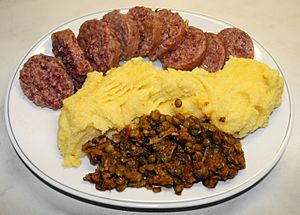Cotechino facts for kids

The cotechino is a special type of Italian sausage. It's quite large and needs to be cooked slowly, usually for several hours. The name cotechino comes from the Italian word cotica, which means "rind" or "skin." This sausage can have different names depending on where it's made in Italy.
In Italy, it's a tradition to eat cotechino with lentils on New Year's Eve. People believe that the small, round shape of lentils brings good luck and money for the coming year!
Cotechino is made by filling a natural casing (like a sausage skin) with a mix of pork rind, pork meat, and fat. This mix is seasoned with salt and spices. Sometimes, special ingredients are added to help keep it fresh for longer. There are other similar Italian sausages too, like musetto (made from pig's snout meat) and zampone (which uses the pig's front leg skin as its casing).
Types of Cotechino
There are different kinds of cotechino, and some are very famous!
The cotechino Modena is a special type that has a "Protected Geographical Indication" (PGI) status. This means its unique recipe and how it's made are protected by Italian and European laws. It ensures that Cotechino Modena is always made in a specific way and place.
Six regions in Italy officially recognize cotechino as a traditional food:
- Emilia-Romagna: This is where the famous Cotechino Modena comes from.
- Lombardy: You can find cotechino in cities like Cremona, Bergamo, Mantua, and Pavia.
- Molise: This region also has its own traditional cotechino.
- Trentino: Here, they make a pork cotechino.
- Veneto and Friuli-Venezia Giulia: These two regions have many different types! Some examples include coeghin nostran from Padua, coessin from Vicenza, and musetto from Friuli-Venezia Giulia.
- Irpinia: This area makes a cotechino called cotechino pezzente.
See also
 In Spanish: Cotechino para niños
In Spanish: Cotechino para niños

